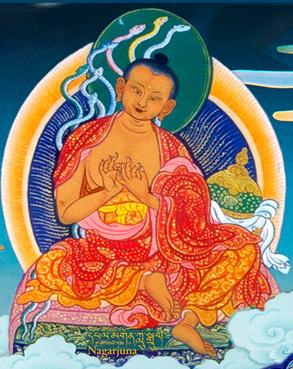Emptiness: Difference between revisions
Jump to navigation
Jump to search
| Line 21: | Line 21: | ||
Nagarjuna does not put forward emptiness as another view ''about'' reality. In fact, he says: | Nagarjuna does not put forward emptiness as another view ''about'' reality. In fact, he says: | ||
:The victorious ones say that emptiness | :''The victorious ones say that emptiness | ||
:Undermines all dogmatic views, | :''Undermines all dogmatic views, | ||
:Those who take a dogmatic view of emptiness | :''Those who take a dogmatic view of emptiness | ||
:Are said to be incurable. | :''Are said to be incurable.'' | ||
And: | And: | ||
:I prostrate to [[Gautama]], | :''I prostrate to [[Gautama]], | ||
:Who, out of compassion, | :''Who, out of compassion, | ||
:Taught the sacred [[Dharma]] | :''Taught the sacred [[Dharma]] | ||
:That leads to the relinquishing of all views | :''That leads to the relinquishing of all views.'' | ||
==Alternative Translations== | ==Alternative Translations== | ||
Revision as of 16:19, 7 August 2016

Emptiness (Skt. śūnyatā; Tib. སྟོང་པོ་ཉིད་, tongpa nyi; Wyl. stong pa nyid) — the absence of inherent existence in all phenomena, which was explained by the Buddha in the sutras of the second turning of the Wheel of Dharma, and further elaborated upon by masters such as Nagarjuna and Chandrakirti.
Sogyal Rinpoche says:
- "Unfortunately, the word ‘emptiness’, which is used to translate the Sanskrit term shunyata, carries a connotation of a nothing-ness, or a void. Happily, there is a wonderful definition in Tibetan that captures its true meaning: Tib. རྟག་ཆད་དང་བྲལ་བ་, tak ché dang dralwa, which translates as: ‘free from permanence and non-existence'.
- Generally, all philosophies tend to fall into one of two extremes: ‘eternalism‘: believing in the existence or permanence of something, or ‘nihilism‘: believing in non-existence. Shunyata goes beyond both of these extremes, because it is neither permanent nor non-existing, and that is, ultimately, how things are."
The Analogy with Space
Shunyata is often compared to space, which is defined in Buddhism as the complete openness, or 'unobstructedness', which allows anything to occur. Likewise, because reality is 'empty' and not fixed in any way, it is said that anything is possible. As Nagarjuna said:
- To whomever emptiness is possible,
- All things are possible.
Subdivisions
The Emptiness of Emptiness
Nagarjuna does not put forward emptiness as another view about reality. In fact, he says:
- The victorious ones say that emptiness
- Undermines all dogmatic views,
- Those who take a dogmatic view of emptiness
- Are said to be incurable.
And:
- I prostrate to Gautama,
- Who, out of compassion,
- Taught the sacred Dharma
- That leads to the relinquishing of all views.
Alternative Translations
- great emptiness
- voidness—an absence of an impossible way of existing (Alexander Berzin).
Oral Teachings Given to the Rigpa Sanhga
- Sogyal Rinpoche, Winterberg, Germany, 30 October 2014
- Sogyal Rinpoche & Patrick Gaffney, Lerab Ling, 6-12 August 2016
Edited Teachings of Sogyal Rinpoche
- Rigpalink January 2010, 'The View of Shunyata - part 2', Lerab Ling, 26 September 2008; Barcelona 10 & 11 October 2009 (available in English, French, German and Spanish, ordernumber 731)
- Rigpalink December 2009, 'The View of Shunyata - part 1', Lerab Ling, 13 August 2009; Barcelona, 10 October 2009 (available in English, French, German and Spanish, ordernumber 730)
- Rigpalink June 2000, 'Shunyata – The Nature of Reality', Paris, 19 April 2000 (available in English, French, German, ordernumber 321)
Further Reading
- A Treasury of Dharma, aka The Mengak Study Pack (Lodève: The Tertön Sogyal Trust, 2005), pages 68-74.
- Khenpo Tsultrim Gyamtso Rinpoche, Progressive Stages of Meditation on Emptiness (Auckland: Zhyisil Chokyi Ghatsal Publications, 2001).
- Thinley Norbu, The Small Golden Key (Shambhala Publications, 1999), ‘7. Great Emptiness'.